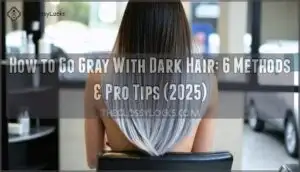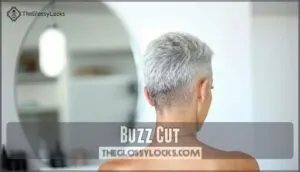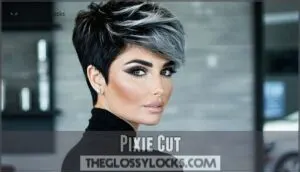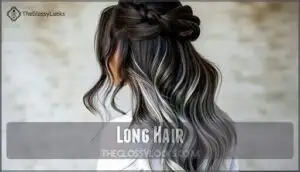This site is supported by our readers. We may earn a commission, at no cost to you, if you purchase through links.
 Going gray with dark hair means picking a transition method that works for you. Every option has its ups and downs—how long it takes, what it costs, how obvious the change is.
Going gray with dark hair means picking a transition method that works for you. Every option has its ups and downs—how long it takes, what it costs, how obvious the change is.
Cold turkey? Buzz or pixie cut the dyed parts, then let your natural silver come in. Gray blending is gentler—highlights and lowlights at the salon over a few months fade things gradually. Or you can strip the old dye with color remover, or dye everything gray to match what’s growing in.
You’ll need patience because natural gray comes in coarser and thirstier for moisture. But once it’s healthy and shiny, the look is totally worth the wait.
Table Of Contents
- Key Takeaways
- How to Go Gray?
- Going Gray: Cold Turkey
- Going Gray: Salon Transition
- Going Gray: Dye Strip Technique
- The Easiest Way to Go Gray
- Growing Out Gray Hair
- Adjusting Haircare Maintenance
- Avoiding Brassiness
- Inspiration for Going Gray
- Frequently Asked Questions (FAQs)
- How should I prepare for the transition to gray hair?
- Are there any health risks associated with stripping hair dye?
- What should I do if I have gray hair but still want to dye my hair?
- How often should I use purple shampoo or conditioner?
- Does gray hair require special styling products?
- How long does gray transition typically take?
- Can I go gray with very dark hair?
- What products help gray hair look better?
- Does gray hair texture change from original color?
- Conclusion
Key Takeaways
- You can shift from dark hair to gray using cold turkey cuts (buzz or pixie), gray blending with highlights and lowlights over several months, dye stripping, or dyeing your entire head gray to match incoming roots. – Gray blending through salon highlights offers the easiest and fastest path to silver hair in 6–9 months, requiring visits every 8–10 weeks without the harsh demarcation line of growing out roots naturally. – Gray hair has a coarser, drier texture than pigmented hair and needs extra moisture through weekly deep conditioning, purple shampoo to prevent brassiness, and UV protection to avoid yellowing. – The dye strip technique lets you maintain a narrow strip of dyed hair along your part while gray grows underneath, eliminating visible roots and completing the transition in 12–16 months without anyone noticing the change.
How to Go Gray?
So, how do you actually make the leap from dyed dark hair to your natural silver? You’ve got options, and each one works differently depending on your lifestyle and patience level.
Every approach has its pros and cons. Consider how much change you can handle at once, whether you’re up for regular salon appointments, and how patient you’re feeling.
Going gray isn’t something you rush—it’s more of a process you ease into.
Each gray shift method has trade-offs, so think about your hair color choice, how often you’re willing to make a salon visit, and what your patience expectations look like. Embracing gray hair is a journey, not a race.
Going Gray: Cold Turkey
The tricky part is figuring out what to do while it grows out—and that really depends on how short or long your hair is right now, plus how drastic a change you can handle.
You’ll need to decide how to handle the growing-out phase, which depends on your current hair length and how much change you’re ready for.
Buzz Cut
If you’re ready to make a bold move, a buzz cut offers the fastest route to embracing your natural silver. This haircut strips away all the dyed hair at once, revealing your true gray color underneath. You won’t need to worry about regrowth challenges or the hassle of weaving highlights to blend your hair color shift.
Keep in mind that buzz cut maintenance is simple, but you’ll want to protect your scalp from sunburn with hats or sunscreen.
Your head shape becomes more visible with buzz cut styles, so consider if you’re comfortable with that while shifting to gray and styling your natural gray hair.
Pixie Cut
A pixie cut gives you all the confidence of a buzz cut but with a bit more softness and styling flexibility as your gray grows in. You’ll work with your hair stylist to find pixie cut styles that complement your face shape and hair texture.
Pixie maintenance stays simple—regular trims every four to six weeks keep the shape fresh. Styling options open up as your silver grows, and you can use gray blending techniques with highlights if you want smoother color blending during your color change.
Long Hair
Keeping your length while going gray means you’ll watch that silver line move slowly down your strands—patience becomes your best friend here. Long hair maintenance requires commitment, but you can make the hair color shift smoother with smart strategies:
- Use protective styles long like braids or buns to hide the demarcation line between your natural gray and dyed ends
- Weave in highlights for gray blending long hair—this softens the contrast and prevents harsh lines
- Deep condition weekly for long hair hydration, since gray hair tends toward dryness and your bleached ends need extra care
Regular trims remove hair damage from previous hair treatments while keeping your length manageable during the shift from dark to grey hair journey.
Pros and Cons
Choosing how to transition means picking your battles. Go cold turkey and you’ll pocket the salon cash, but you’re signing up for months of that telltale line marching down your part.
People might make comments—gray hair still carries baggage about "giving up" on yourself. Your hair will thank you, though. Without the chemical beating, it’ll actually get healthier as it grows.
How long this takes depends entirely on your hair length. Buzz it short and you’re done in weeks. Keep it long and you’re looking at years of growing out. Either way, maintenance is easy. If the two-tone look feels too jarring, highlights can soften the transition—but that costs money and adds salon time back into the mix.
Time commitment varies: buzz cuts fast-track your gray hair journey in weeks, while long hair stretches the shift over years. Maintenance effort stays minimal, but gray blending through highlights offers smoother shifts if the waiting game feels too rough.
Going Gray: Salon Transition
If you’re not quite ready to watch your roots grow out for months on end, salon techniques can help you ease into your gray hair without the stark line of demarcation. Salon consultations give you a chance to map out a custom plan based on your current color and how much gray you’ve got coming in.
When you sit down with your colorist, they’ll start by assessing where you are now and sketching out a roadmap. Fine highlights will be placed strategically near your hairline to echo how gray naturally comes in. They’ll also weave in lowlights, adding depth so nothing looks flat.
Toning treatments knock out any brassy yellow or orange tones, keeping things clean and silver. Regular trims clear away damaged ends and keep your shape sharp.
Plan on coming back every six to eight weeks to maintain the blend as your roots push through.
What to expect during salon visits:
- Your colorist applies fine highlights near your hairline to mimic natural graying patterns
- Lowlights are woven through to add depth and prevent a flat, one-dimensional look
- Toning treatments neutralize orange or yellow undertones for a cleaner silver
- Regular trims keep your style fresh and remove old, damaged ends
- Follow-up appointments every 6–8 weeks maintain the blend as your roots emerge
Going Gray: Dye Strip Technique
Why settle for watching roots creep in when you can keep your dark color on top and grow gray underneath? The dye strip technique lets you maintain a narrow strip of dye along your part—usually about 1.5 inches wide—while your natural gray hair growth happens beneath.
This approach eliminates the dreaded demarcation line that comes with shifting from dark to grey hair. You’ll touch up that strip every four weeks, using root concealers or temporary products to polish the look between sessions.
Most people finish their shift timeline in 12 to 16 months without anyone noticing the change. When you’re ready, flip your part to reveal your silver—no awkward stages, no hair bleaching drama. For a detailed guide on this method, consider learning about gray hair techniques.
The Easiest Way to Go Gray
Want to skip the awkward grow-out phase and land on silver fast? Gray blending offers your quickest path forward. Your colorist weaves silver highlights through your dark hair, creating a natural shift that disguises regrowth lines while you’re shifting from dark to grey hair.
You’ll need salon visits every 8–10 weeks, plus weekly purple shampoo to fight brassiness.
This hair color shift method delivers gorgeous silver locks in 6–9 months—no hair dye removal or hair bleaching needed. It’s the gentlest natural shift for your strands and the smoothest ride to embracing your gray hair.
Growing Out Gray Hair
Ready to go gray? You’ve got options.
Each one works at a different speed and asks for a different level of commitment, so pick what actually fits your life.
Each method offers a different pace and level of commitment, so you can choose what fits your lifestyle and comfort zone.
Letting Roots Grow
Letting your natural gray roots grow out for at least two inches creates a clear starting line that makes the whole shift smoother and more predictable. This root regrowth phase is your foundation—it shows you exactly what you’re working with and helps you plan your next steps.
During this awkward phase, root concealers become your best friend for covering the demarcation line between your dark hair and incoming silver. These products blend the contrast without commitment, buying you time while shifting from dark to grey hair. Use root touchups for quick fixes on visible areas like your part and temples.
Purple shampoo keeps emerging grays bright, while deep conditioning treatments twice monthly maintain strength. This waiting period sets you up for successful gray blending later.
Weaving Highlights/Lowlights
Highlights and lowlights act like a bridge between your dark base and emerging silver, softening the harsh line while you grow out your natural color. Your colorist can weave in lighter ribbons using balayage or foil techniques, blending gray strands with your existing shade through strategic highlight placement.
Lowlights add depth where needed, creating dimension that makes the hair color shift less jarring. This gray blending approach follows color theory principles—placing tones that naturally graduate from dark to light. You’ll see a softer demarcation line and a more forgiving grow-out period.
Removing Old Hair Dye
Bleach works faster, but it’s rough on your hair.
Studies show that about two-thirds of bleach-treated hair ends up dry and damaged, compared to less than one in five with milder color removers.
Bleaching agents work faster but carry higher risk: 65% of bleach-treated samples show dryness and breakage versus 18% with gentler formulas.
Your colorist will assess your hair’s history, then choose the right developer strength and follow with bond-building treatments to protect fragile strands during color correction. To achieve the best results, understanding color stripping methods is essential for a successful color transformation.
Dyeing Hair Fully Gray
If stripping feels too risky or incomplete, you can skip the waiting game entirely and dye your whole head gray to match your incoming roots.
Professional gray dye methods require pre-lightening dark hair—usually with bleach—then layering silver toner to neutralize brassy tones. Your colorist will assess hair porosity and choose bond-building formulas to minimize dye damage repair needs.
This color correction approach delivers instant results but demands careful gray toning maintenance to keep your changing hair vibrant and healthy.
Adjusting Haircare Maintenance
Once you ditch the dye, gray hair demands a different approach. Those silver strands? They’re naturally drier and coarser than pigmented hair, which means keeping them hydrated isn’t optional.
Your gray hair needs a whole new game plan once you stop dyeing it. Natural silver strands are drier and coarser than pigmented hair, so hydration tips become your best friend.
Swap in a gray shampoo weekly to keep tones bright, and use hair masks regularly—they’ll add moisture and shine. Don’t skip scalp care either; a healthy foundation means stronger growth.
Deep conditioning treatments protect your hair care and maintenance routine, while gentle brushing prevents breakage. This haircare routine isn’t complicated, but it’s essential for color preservation and keeping your gray looking healthy and vibrant.
Avoiding Brassiness
Once you’ve nailed your new maintenance routine, brassiness can still sneak up on you. Yellow or orange tones show up when UV rays, mineral buildup, or leftover hair dye oxidize on your strands. Gray hair lacks melanin, making it 30% more vulnerable to sun damage than pigmented hair.
Purple shampoo is your go-to for brass prevention. Use it once or twice weekly—violet toning shampoos deposit pigments that neutralize yellow. If you’ve got darker natural hair mixed in, blue formulas work better against orange. Don’t overdo it, though, or you’ll end up with violet staining.
Hard water is a sneaky culprit. Copper and iron deposit on your hair shaft, causing that brassy cast. A clarifying treatment monthly lifts mineral buildup, and a showerhead filter can cut visible brassiness by up to 45%. For gray toning on the go, wear a hat outdoors—UV protection reduces sun-induced yellowing by about 25% over summer. Clay masks twice monthly pull out environmental gunk and restore your silver shine.
Inspiration for Going Gray
Watching someone else’s gray hair journey unfold can flip the switch from "I’m not sure about this" to "I’m ready to start tomorrow." Finding gray role models—whether they’re celebrities, coworkers, or strangers on social media—shows you what silver style actually looks like in real life.
Seeing others rock their silver strands can shift you from doubt to commitment overnight
Start by following hashtags like #grayhairjourney or #silversister. You’ll find women at every stage of shifting from dark to grey hair, sharing honest before-and-afters. YouTube channels document the full process, week by week, so you can see how long it really takes.
Look for people with your hair type and lifestyle. Their struggles with brassiness or styling tricks become your roadmap. Embracing natural gray hair isn’t just about aging positively—it’s about hair freedom and natural beauty on your terms.
The gray hair community celebrates wins and shares solutions. When you see someone rocking silver strands with confidence, it reminds you why you started this journey in the first place.
Frequently Asked Questions (FAQs)
How should I prepare for the transition to gray hair?
Think gray hair planning is all about patience and purple shampoo? Let your roots grow naturally, weave in highlights or lowlights for smooth gray blending, and prep with toner or glosses.
Use deep conditioning masks to maintain hair health during your color shift—your new silver deserves that much.
Are there any health risks associated with stripping hair dye?
Yes, color stripping can cause hair damage and scalp irritation. Wear gloves, avoid eye contact, and follow instructions carefully.
Bleach and developer carry chemical risks, including dryness and potential dye allergies, so proceed cautiously.
What should I do if I have gray hair but still want to dye my hair?
Want to keep dyeing your gray hair? Choose permanent or demi-permanent formulas for the best gray coverage. Pick products made for gray hair—they stick better to coarse, dry strands and give even color.
If you’re shifting from dark to grey hair, start with highlights or lowlights to soften the change.
How often should I use purple shampoo or conditioner?
Like tuning a guitar to keep it pitch-perfect, purple shampoo needs the right frequency to maintain your silver locks. Use it once weekly to neutralize brassy tones without overdrying your hair.
If brassiness appears faster, bump it up to twice weekly, but watch for purple staining or dryness that signals you’re overdoing this color correction routine.
Does gray hair require special styling products?
Gray hair has a different texture than pigmented hair, so it needs its own care routine. Specialized styling products really help.
Look for hydrating formulas and shine serums to bring back luster—gray strands are often coarser and need that extra moisture. Heat protectants are key since the texture shift makes hair more vulnerable to damage. Purple-tinted styling products neutralize yellow tones, while mousses restore volume that gray hair typically loses.
Think of gray hair as a new texture that needs different care. Absolutely—gray hair benefits from specialized styling products.
Look for hydrating formulas, shine serums to boost luster, and heat protection since texture changes make strands more fragile. Purple-tinted styling products tackle brassiness while mousses add volume boost gray hair often loses.
How long does gray transition typically take?
How rapidly will your transformation unfold? Changing to gray usually takes six months to two years, depending on hair growth speed, pigment loss rate, and your starting color. The awkward phase—where new gray meets old dye—lasts longest without gray blending or salon help.
Individual variation means some see faster repigmentation potential, while others experience gradual change. Growing out gray hair demands patience as your natural silver emerges.
Can I go gray with very dark hair?
Yes, you can transition from very dark hair to natural silver, but it’s not a quick process.
The main hurdles? That obvious line where dark meets gray, and the fact that going gray takes time when you’re starting from dark.
A salon can help smooth things out with gray blending or gradual color shifts, which makes the growing-out phase a lot more manageable.
Salon color correction through gray blending or hair color conversion methods helps manage expectations during this evolving journey.
What products help gray hair look better?
Gray hair products sound tricky until you actually look at what they do. Purple shampoos cancel out brassy yellow tones, while deep conditioners bring back softness that gray hair tends to lose.
UV sprays stop sun damage from turning your silver yellow, and root touch-up powders hide the grow-out phase.
If your hair’s gone flat, texturizing spray adds body back.
UV protection prevents yellowing. Root concealers mask regrowth. Texturizing sprays add volume.
Does gray hair texture change from original color?
Gray hair texture often feels coarser and drier than pigmented strands. Melanin loss effects change hair porosity, making gray strands more porous and prone to absorbing moisture differently.
Hair follicles produce hair with structural protein changes that affect manageability differences.
The switch itself isn’t the problem—it’s how you do it. Bleach and dye can weaken your hair and make gray strands more porous, which leads to damage.
Going cold turkey skips all that. If you’re doing a salon change, ask about bond-building treatments. They protect your hair and keep damage to a minimum.
Making the change itself won’t harm your hair, but the methods you choose matter. Bleach and hair dye can weaken hair structure and increase gray hair porosity, causing damage.
Cold turkey avoids these risks entirely. Using bond-building treatments during salon changes protects hair follicles and minimizes damage risks from changing your look.
Conclusion
There’s no turning back once you take the plunge, but learning how to go gray with dark hair opens the door to simple style and authenticity.
Whether you buzz it short, blend with highlights, or strip the color entirely, your silver can shine with the right care.
Embrace the coarser texture with deep conditioning, and keep brassiness at bay using purple shampoo. Your natural gray is a statement worth celebrating.
- https://treendly.com/blog/silver-lining--the-surging-popularity-of-gray-blending-in-hair-color-trends-2023
- https://www.vogue.com/article/transitioning-to-gray-hair
- https://katiegoesplatinum.com/surprising-truth-about-transitioning-gray-hair/
- https://elifesciences.org/articles/67437
- https://studio.salonory.com/education/how-to-transition-to-gray-hair/













